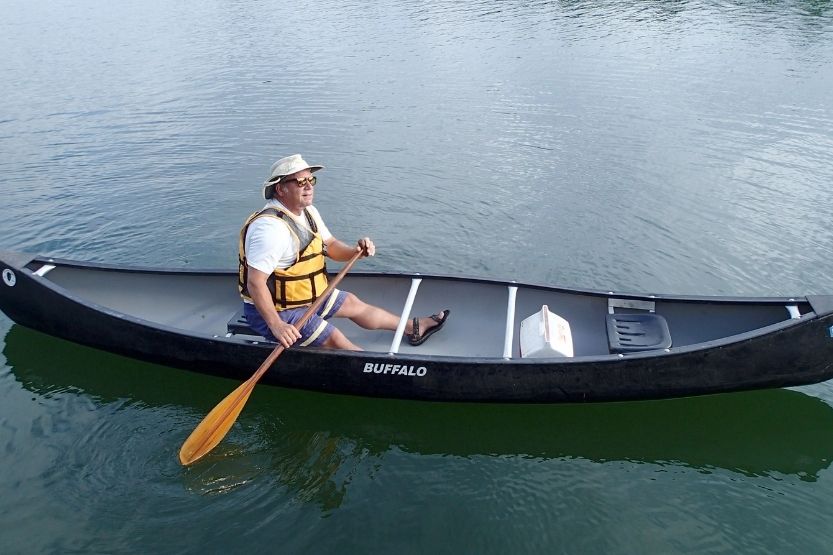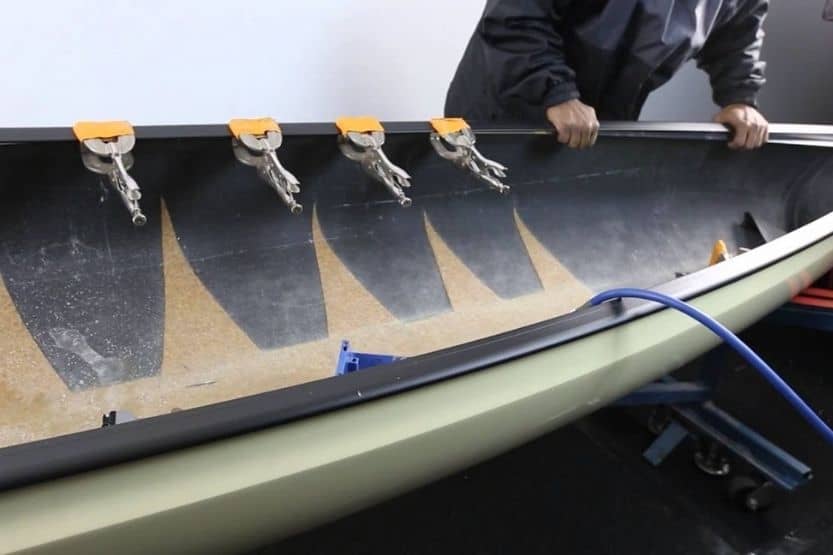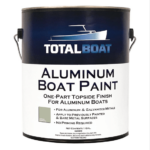If you really want a durable canoe, you would go for aluminum. These canoes are known to be the strong silent types. You may assume that even if it is a metal, aluminum is soft, so why would you want to buy an aluminum canoe?
The main benefit of canoes made of aluminum is that they are very durable. They might be a bit slow on the water, but they are a great choice if you are prone to hitting solid objects like rocks. These canoes are actually a bit pricier than those which are made of other materials.
Aside from being hardy, an aluminum canoe is ideal for recreational boating. This canoe you would like if you are looking for a simple but tough boat and one that requires very little maintenance.
Read on to learn more about aluminum canoes, their pros and cons, and how they compare to fiberglass canoes.
Also, we hope you find the links here useful. We may get a commission if you purchase something through a link on this page, so thank you!
Aluminum Canoe

Of all watercraft, the aluminum canoe has a reputation for being the strong silent type. They may be a bit slow on the water, but they are very durable. If you are prone to hitting solid objects like rocks, don’t worry. Aluminum is resistant to cracking and breaking.
If there’s damage to the metal’s surface, you can restore its integrity by welding the damaged part. An aluminum canoe is not likely to sink easily. While aluminum is soft, it is combined with other metals such as silicon, nickel, and magnesium to make it hard enough for boat building.
Aluminum is also a good boat material because it needs very little maintenance. A canoe made of this metal will provide a simple but tough watercraft that you can use for fishing or flatwater paddling trips with family and friends.
Aluminum canoes are generally lighter than those made of wood. But it can be heavier compared to other more modern invented materials such as Kevlar. Therefore they are better for recreational water activities instead of wilderness trips.
While they built more aluminum canoes in previous decades, they are not as popular today. This is due to the development of more modern boating materials. Modern boats have complex curve designs, which are very hard to form with aluminum. Therefore it is seldom that you will see complex curve shapes on aluminum canoes.
Aluminum Canoe Weight – Are Canoes Made of Aluminum Heavier?
The average aluminum canoe weight is between 60 and 75 pounds. They are generally lighter than wooden canoes. Light composite materials such as Kevlar weigh around 20% less than canoes with similar fiberglass or aluminum designs. The actual weight of a specific boat really depends on several factors.
A typical 2-person aluminum canoe that measures 16 feet long can hold a maximum weight of about 940 pounds. An ordinary canoe of about 14 feet can accommodate 2 boaters can carry around 700 pounds, including gears.
Click here to see this MAXZONE Automatic Submersible Boat Bilge Water Pump on Amazon.
Aluminum Canoe Pro and Cons
Being made of a light and durable material, aluminum canoes have certain advantages over other canoes made of other materials. It has some disadvantages too.
Pros
- They can serve as a source of distractive noise for bears and other wildlife on wilderness camping trips.
- Aluminum is a fully recyclable material. It is environmentally friendly.
- They are very durable and can last many lifetimes.
- Generally, they are highly resistant to rust.
- During a wind storm out in the wilderness, you don’t need to stake an aluminum canoe just like you would with a wooden canoe.
- The initial stability of these canoes once put on the water is very high.
- You can leave an aluminum canoe out in the sun and snow, and it will maintain its integrity,
- They can carry bigger loads without compromising their handling capabilities.
- Most dings are easily repaired using a rubber mallet.
- They have flat bottoms that can serve as dining tables at the campsite.
- They can be used as heat reflectors of campfires at campsites.
Cons
- They are heavier than canoes made of composite materials.
- This makes them slow on the water compared to other canoes made of other materials.
- Aluminum is a noisy metal. An aluminum canoe being carried over one’s head will serve as an echo chamber, which could be disturbingly noisy.
- Aluminum is a metal that can be cold to the touch.
- They tend to stick to rocks instead of sliding over them.
- The cost or price of aluminum is higher. Canoes made of aluminum could be a target for scrappers.
- They are overly shiny under sunlight.
Click here to see this O’Neill Men’s Superlite USCG Life Vest on Amazon.
Aluminum vs Fiberglass Canoe – Which Is Better?
Fiberglass is another canoe material that offers durability and long life. However, when it comes to durability and easy maintenance, the aluminum canoe is better. Aluminum is a powerful vessel that requires very little maintenance making it better than fiberglass.
Here are other things that you may want to consider if you are torn between aluminum vs fiberglass canoe.
Aluminum Canoe
Another plus for aluminum canoes is they are resistant to UV light. They are also able to withstand the adverse effects of the elements. You can leave them outside and still expect them not to be adversely affected by the environment.
While they can resist UV light, they can be hot under the sun. At night, they can be freezing. Whichever of these two conditions exists, the aluminum canoe will be uncomfortable to be in.
But they are good for beginners, especially the kids, because of their high water stability. These boats can take a lot of knocks and bumps without being considerably affected structurally. If there are dings and dents from rock bumps, you can easily repair them. Should holes develop, they can be repaired by welding.
While there are many plusses for aluminum canoes, they also have some minuses. One of their disadvantages is that they tend to be slow on the water. That’s due to the way they are built. Basically, they are composed of two aluminum metal sheets that are riveted together to form a canoe.
They are also heavier to lift. So if you are always portaging in your wilderness trips, you may want to consider this aspect of aluminum canoes.
Fiberglass Canoe
Fiberglass canoes are basically made from glass fibers bonded together by a resin material. The fibers are laid out in a mold, and then resin is applied to them. Then they are left to cure or harden inside the mold at a specified time. To give a smooth finish, the surface is usually coated with a smooth gel. This gel adds resistance to scrapes and dents.
This material is commonly used to manufacture canoes. The main reason is that you can create almost any possible boat shape with fiberglass. That is why you can see different types of fiberglass canoes built, from flatwater types to whitewater types. Fiberglass is also easily repaired.
Since molds are used, it is possible to make fiberglass canoes in any shape and form. But most of these canoes are built for efficiency and speed on the water. That is why many fiberglass canoes are pointed on their bows and sterns. This design, however, compromises their stability on the water.

Fiberglass canoes are lighter than aluminum canoes, all things being considered. Therefore, they are faster on the water and will not be as difficult to portage as the aluminum canoe. They are also durable and have many options in shapes and designs.
The bottom line in this issue of aluminum vs. fiberglass canoe is your intention. How do you intend to use the canoe? Is it for weekend fishing and relaxation with family and friends, or is it for more aggressive water sports like whitewater canoeing?
If your intention is for plain entertainment and relaxation, your better option is the aluminum canoe. But if you are the sporty type who occasionally enjoys an adrenalin rush, you are better off with the fiberglass canoe.
Click here to see these Protective Knee Pads on Amazon.
How Aluminum Canoes Are Made
Building an aluminum canoe is not a difficult process, although it takes many steps. The raw material used in the process is aluminum alloy in aluminum rolls of a specific width and thickness. There are several aluminum canoe manufacturers, but they generally follow the same manufacturing process.
Most of them take the following steps:
Shaping the Aluminum Sheet
- Workers will unwind the aluminum roll onto a work table.
- They cut the aluminum roll into aluminum sheets of a certain length using electric shears.
- They place the aluminum metal sheet onto a mold shaped like one part of the canoe hull.
- The workers then clamp the metal to a hydraulic system and activate it.
- Upon activation of the hydraulic system, a heavy metal piece falls on the mold and effectively stamps the metal sheet into its shape.
- Trimming the edges of the stamped metal sheet follows.
- The workers transfer the molded sheet onto a work table.
- They place a template over the contoured section of the metal sheet.
- The workers then clamp the stamped sheet into place with a scribe.
- One worker will etch the pattern onto the stamped aluminum.
- Then they transfer the stamped sheet to a jig.
- The jig cuts out the pattern following the etched outline.
- The workers then shape and cut another aluminum sheet which will be another part of the canoe. It will be molded and shaped just like the first metal sheet.
- After the second part is cut and molded, the workers will put together the two symmetrical parts. They will form the hull of the aluminum canoe.
Baking the Hull Halves
- They will then bake the hull halves at 200 °Celsius for eight hours. This will strengthen the metal and will add rigidity to the structure.
- The hull is then taken out of the oven and allowed to cool down.
- A worker will align the two halves and ensure that they perfectly match each other.
- This worker will lower a big clamp.
- The worker turns a crank that pulls the two parts together so they can clamp them tightly.
- This worker then starts welding the two parts starting at the bottom, joining them with a watertight seal.
- Then he will tack the two rounded ends together and will weld them as well.
- This worker will then link the end welds to the one at the bottom. This will result in one continuous weld from bow to stern and makes the boat leakproof.
- The assembly team will now position an aluminum keel along the seam at the bottom.
- They will reinforce this section from the inside of the hull using an at-bar.
- The workers will then drive rivets through the keel and the t-bar. This will secure the assembly.
- They will then install several aluminum guards using rivets on the stern and the bow to secure them. The aluminum guards are installed to protect the end welds.
- After this, the workers will brace the canoe base from the inside using 6 aluminum ribs that are welded and riveted. This provides a good support structure to the canoe.
- The assembly team will install aluminum gunnels on the canoe’s rim by pounding them with a rubber mallet. This will enhance the fit.

Coating
- Then one worker will apply a coat of non-skid paint on the inside of the hull. This prevents the hull from becoming slippery when wet.
- This paint will be subjected to heat lamps so that it can dry quickly.
- After 30 minutes, the paint will dry.
- The assembly team will then test the boat to see if it will float by transferring it to a water tank.
- The workers will clamp a steel bar across the boat to apply 450 kilograms of pressure. This is the equivalent weight of 2 average-sized persons.
- The workers will check for leaks, especially around the rivets.
- The installation of the bench seating will complete the boat construction.
- The last thing they will do to the boat is to put the company insignia in a distinct place in the canoe.
- The aluminum canoe is now ready for service.
Click here to see this Best Marine Emergency Water Rescue Throw Bag on Amazon.
Conclusion: Aluminum Canoes
One of the primary advantages of aluminum canoes over other boats made of other materials is their durability. They might be slower on the water than other canoes, but they are an excellent alternative if you always tend to hit the rocks while you are boating.
Canoes made of aluminum are actually a bit more expensive than other canoes. If they are pricier, that means they have more to offer than the canoes made with other materials.
What is the average aluminum canoe weight? Aluminum canoes weigh an average of 60 and 75 pounds. They are generally lighter than wooden canoes. Light composite materials such as Kevlar weigh about 20% less than canoes with similar fiberglass or aluminum designs.
Related reading:







![Boundary Waters Canoe Area Wilderness [Activities, Routes, Permits] boundary waters canoe area](https://boatinggeeks.com/wp-content/uploads/2021/07/boundary-waters-canoe-area-150x150.jpg)
![Read more about the article Kayaking in Florida [10 Best Places]](https://boatinggeeks.com/wp-content/uploads/2020/12/kayaking-in-florida-300x200.jpg)

![Read more about the article Boundary Waters Canoe Area Wilderness [Activities, Routes, Permits]](https://boatinggeeks.com/wp-content/uploads/2021/07/boundary-waters-canoe-area-300x200.jpg)